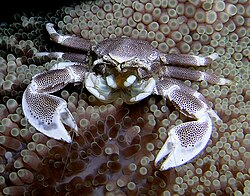| Neopetrolisthes maculatus | |
|---|---|
 | |
| Scientific classification | |
| Kingdom: | Animalia |
| Phylum: | Arthropoda |
| Class: | Malacostraca |
| Order: | Decapoda |
| Suborder: | Pleocyemata |
| Infraorder: | Anomura |
| Family: | Porcellanidae |
| Genus: | Neopetrolisthes |
| Species: | N. maculatus |
| Binomial name | |
| Neopetrolisthes maculatus (H. Milne-Edwards, 1837) | |
| Synonyms [1] | |
| |

Neopetrolisthes maculatus, also commonly known as the Anemone Porcelain Crab [2] , is a species of porcelain crab from the Indo-Pacific region. [3] It is a small, colourful crustacean with a porcelain-like shell. It is usually found within the stinging tentacles of a number of sea anemone species. [1] [4]





